 In the land of the blind the one-eyed woman is queen. 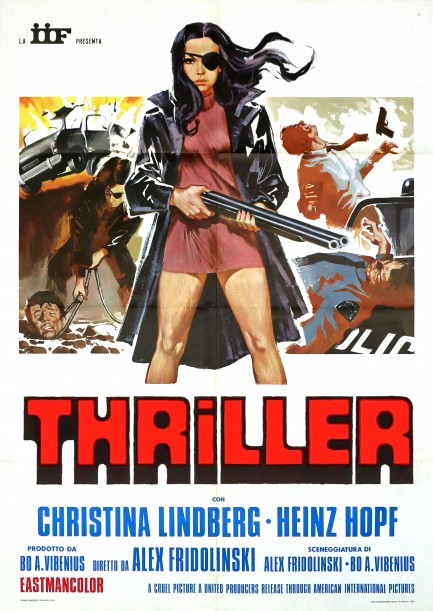 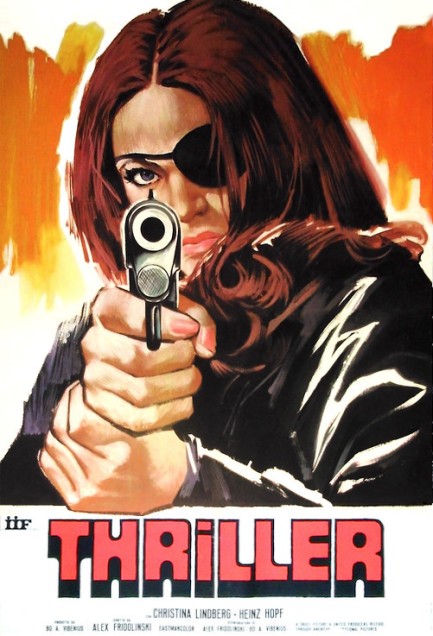 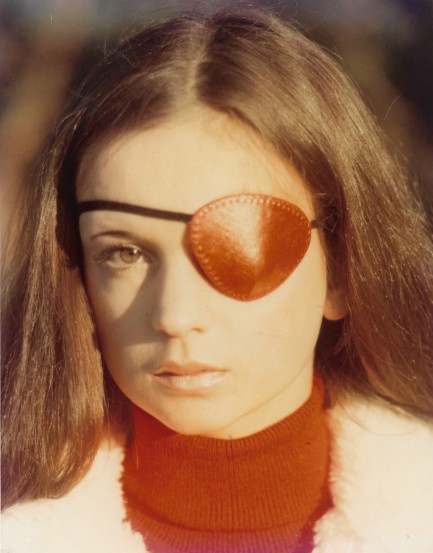
We've done a lot on Sandro Symeoni, which means that just for the sake of completeness we can't overlook these. They're his Italian posters for the Christina Lindberg grindhouse classic Thriller, which was originally made in Sweden as Thriller - en grym film, and in English speaking countries was known as Thriller: A Cruel Picture and They Call Her One Eye. We've already talked about it, and its star.
 *sigh* That was really unpleasant. I don't know why, but I always assumed it was just a euphemism. 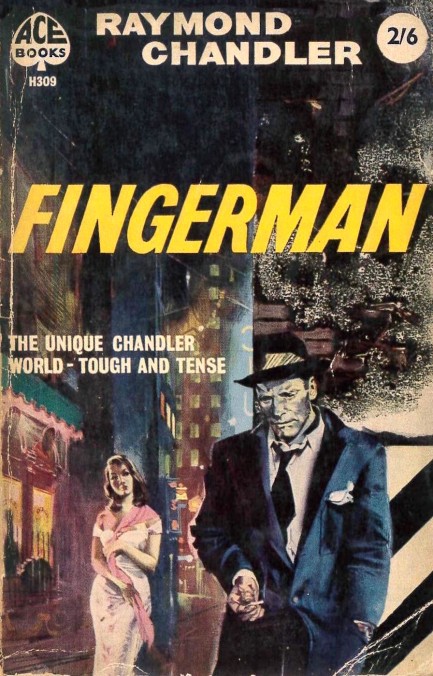
This cover for Raymond Chandler's 1960 story collection Fingerman was painted by an uncredited artist, but once again we're thinking it's Sandro Symeoni on the brush. 1958 to 1960 was when he was working extensively with Ace Books, and this illustration is very much in his style, as we've discussed here and here. The book consists of four offerings: the stories “Finger Man,” which was first published in Black Mask in October 1934, “The King in Yellow,” from the March 1938 issue of Dime Detective Magazine, and “Pearls Are a Nuisance,” also from Dime Detective Magazine, coming in April 1939. The last piece is a Chandler essay titled, “The Simple Art of Murder.” A couple of the aforementioned tales also appeared in Five Sinister Characters. All the stories are good, but we talked about “The King in Yellow” in a bit more detail a while back, so if you're interested feel free to check here.
 Life there is an ongoing domestic disturbance. 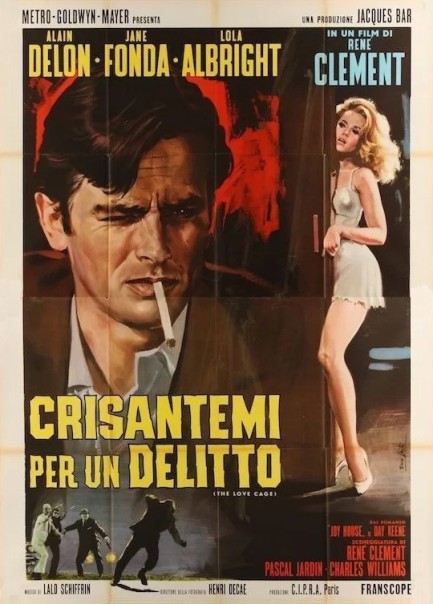 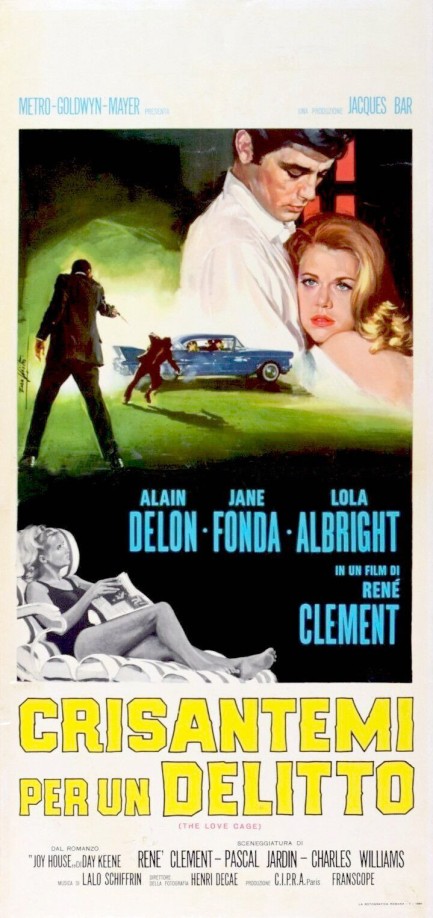
The posters you see here were made for the French thriller Les félins. While the French posters are fine, we thought these Italian promos were a bit more interesting. The first two were painted by Enzo Nistri, the second two by Sandro Symeoni. The movie was called Crisantemi per un delitto in Italy—“chrysanthemums for a crime.” No idea why. But fine, it's lyrical, which is never bad. It's based on the imaginative Day Keene novel Joy House, which is the title the movie retained for its U.S. run. In the book a derelict is plucked from a Chicago homeless shelter by a rich widow who needs a chauffeur, but her benevolence seems likely to backfire because her new driver was in the shelter only because it offered a perfect hiding place from mobsters seeking to kill him. But she has her own secret plans, and they're as sinister as they come. Working from a screenplay co-written by director René Clément and crime author Charles Williams, the movie slightly alters the approach of Keene's book. With Lola Albright playing the widow and Alain Delon as the hunted man, the story is transplanted from urban Chicago to the Côte d'Azur. Pre-Barbarella Jane Fonda features in a co-starring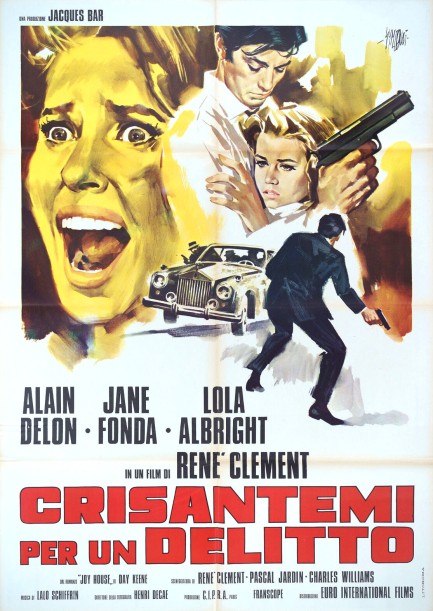 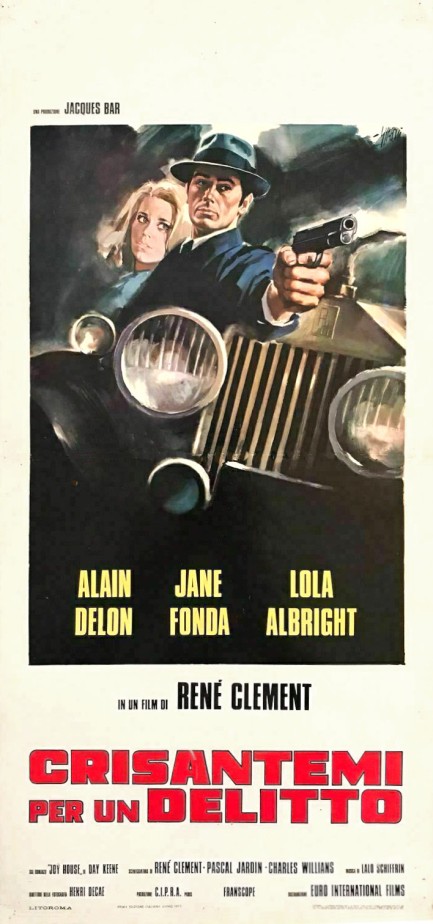 role as Albright's cousin and household helper. The two are soon in competition for Delon's affections, though he never forgets that his main goal is to escape the mobsters. While the general thrust of the plot remains a mystery as in Keene's novel, there's a heavy dose of action too, with excellent stunts. The ending differs as well. role as Albright's cousin and household helper. The two are soon in competition for Delon's affections, though he never forgets that his main goal is to escape the mobsters. While the general thrust of the plot remains a mystery as in Keene's novel, there's a heavy dose of action too, with excellent stunts. The ending differs as well.
The result is good, but also an example of both the highs and lows of French cinema of the period. Delon, Fonda, and Albright are decent actors bestowed a good script, and are all gorgeous and charismatic, but the movie spends a lot of time being cute. Even so, Clément and company pull it all together. Make sure you appreciate the production design, especially the Rolls Royce that Delon drives, with its completely transparent roof, c-pillars all. It's something we never knew existed. To us it looked like a good way to get heatstroke, but we guess it was made for rich occupants to see and be seen. We think Joy House should be seen. It premiered in France in June 1964, then opened at the Taormina Film Fest in Italy today the same year.
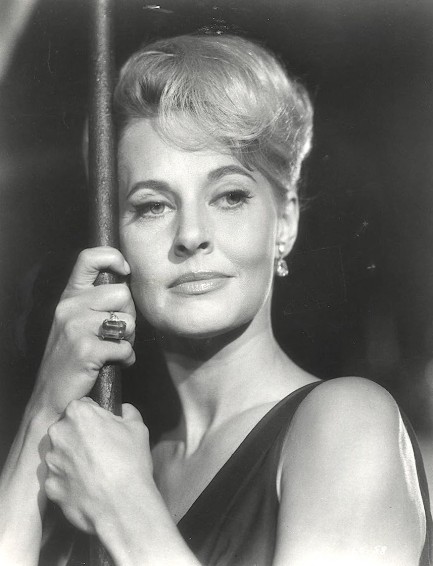  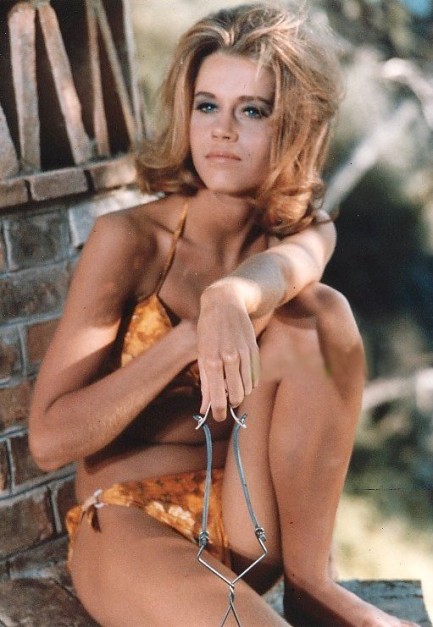 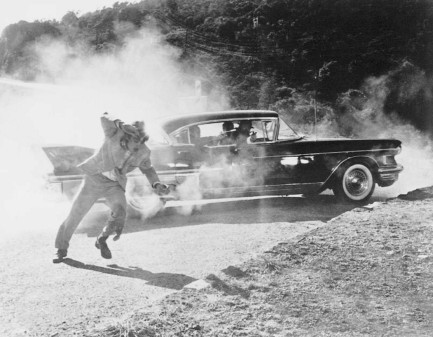 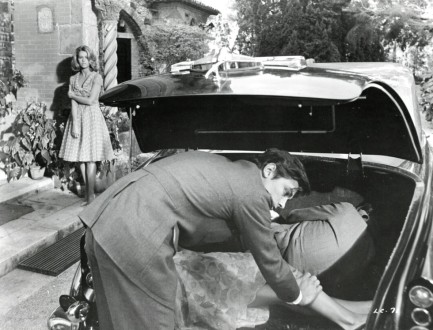 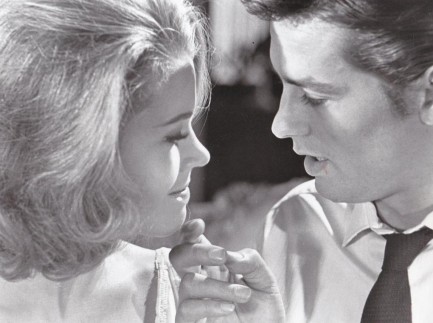 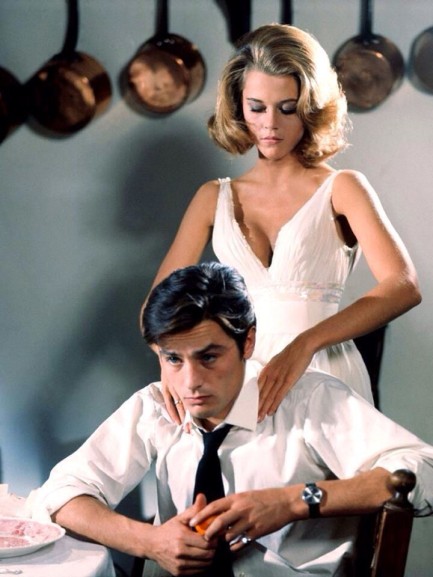 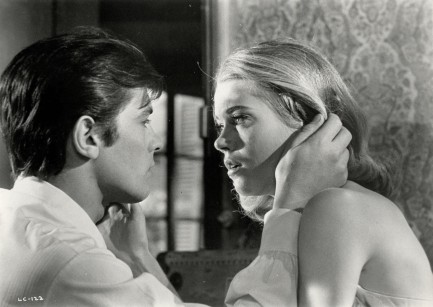 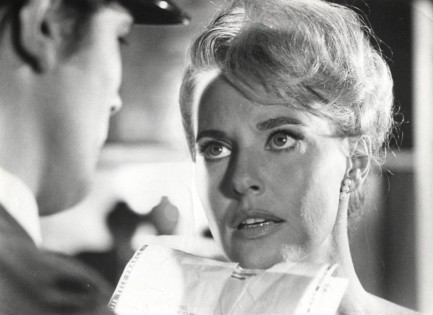 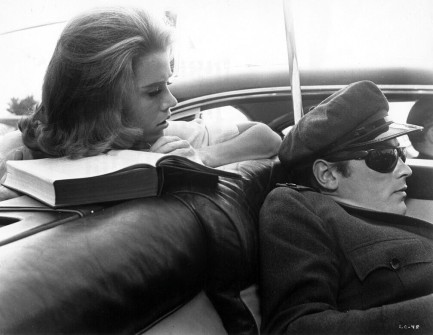 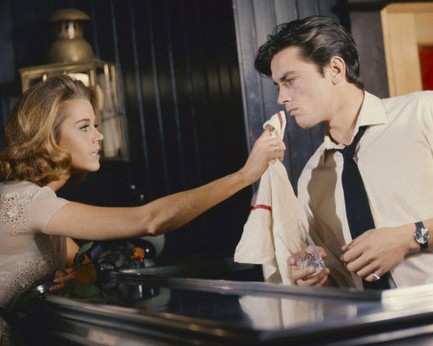 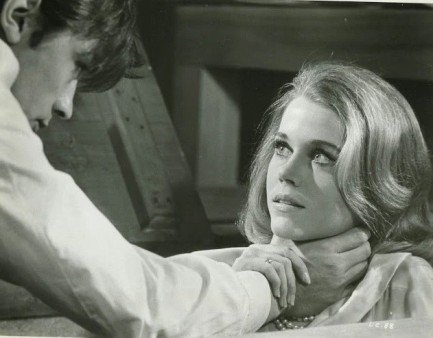 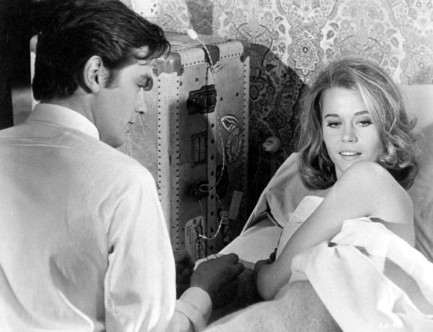 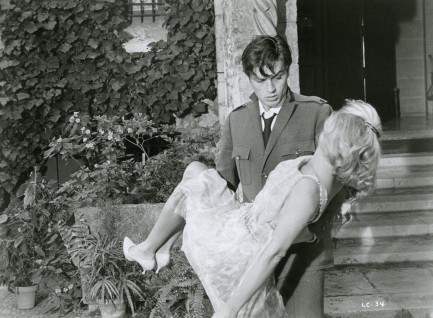 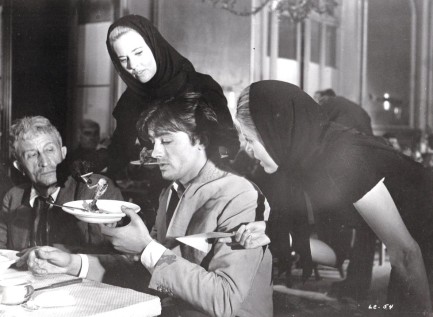 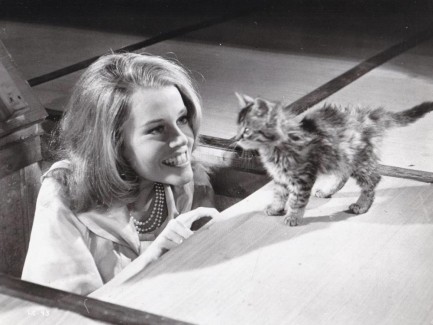 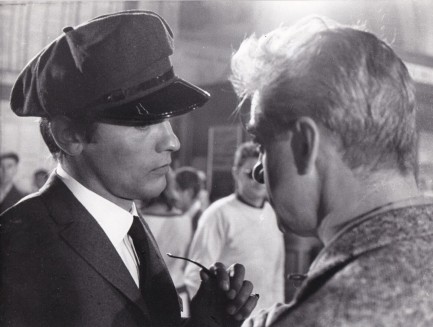 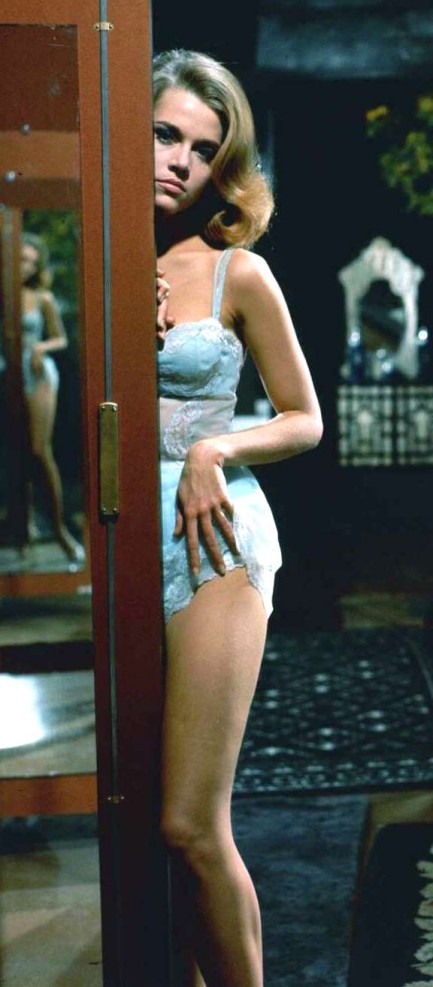 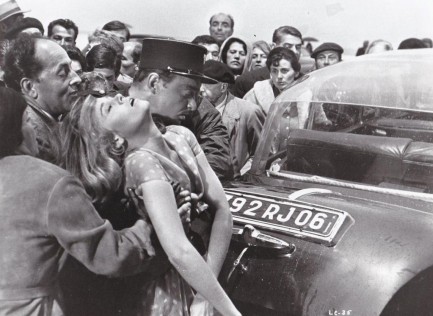 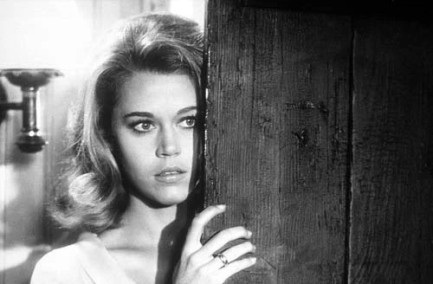 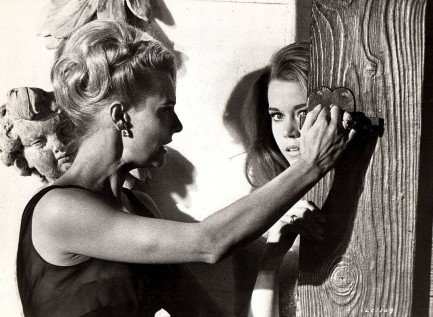 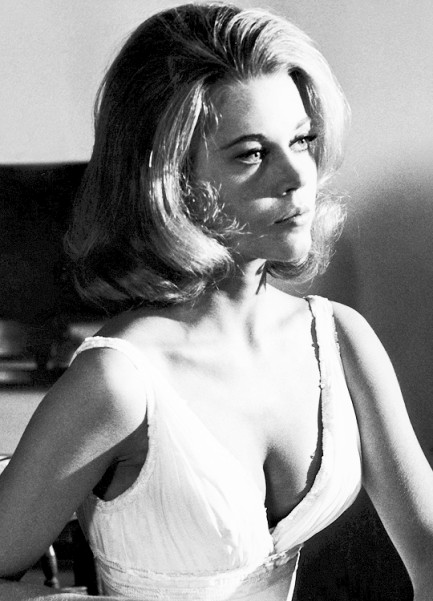
 At least we're still in love after all these years, honey. You're in love with a waitress, and I'm in love with a cabana boy. 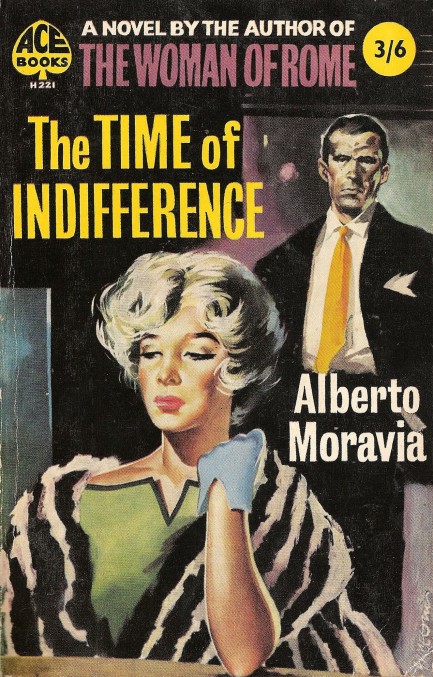
We're back to Italian illustrator Sandro Syemoni today, who we consider a genius in his field. Above you see his cover for Ace Books' 1958 edition of Alberto Moravia's The Time of Indifference, which was originally published in 1929 as Gli indifferenti. We gather it was quite a racy book and it sold out in weeks. Ace, as we've mentioned before, repackaged a lot of literary fiction with newly provocative covers. If you're going to go that route, Symeoni was close to the best. See what we mean here and here. And check some of his poster work here.
 The artist is actually the one who's out of this world. 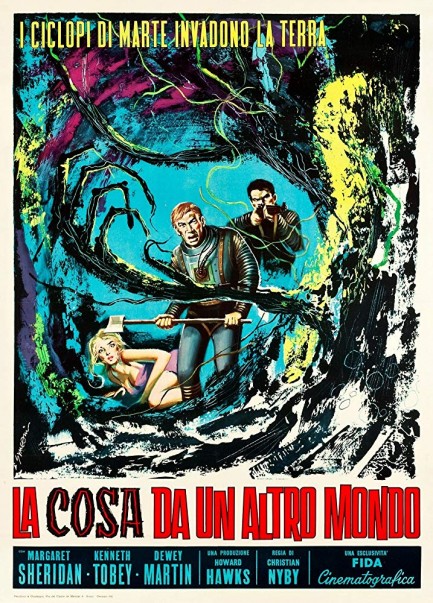
Above is the Italian poster for the sci-fi/horror movie La cosa da un altro mondo, which opened in Italy today in 1952 but originally premiered in the U.S. in 1951 as The Thing from Another World. We talked about it several years ago while sharing its Belgian promo. Today's effort is the work of Italian illustrator Sandro Symeoni, a genius who painted in so many modes he can be unrecognizable from piece to piece. See some of his best work here, here, and here.
 Italian shockumentary about Africa is all voyeurism and no reflection. 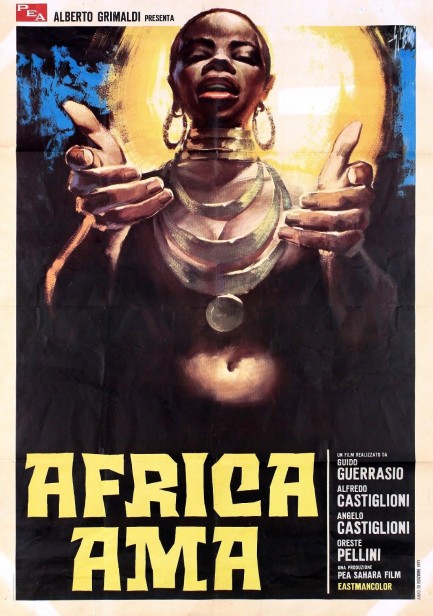
Lately we've been highlighting Italian illustrator Sandro Symeoni's brilliant paperback covers, but today we've decided to bring him back as a poster artist, which is how he first found acclaim, and why we first noticed him. He painted this for the schockmentary Africa ama, which would translate as “Africa loves,” but is known in English as Africa Uncensored. 1970s shockumentaries have an educational veneer, but are mostly about cultural titillation and making viewers in modern countries lose their lunches, as practices such as male and female circumcision, animal killing, and scarification are filmed unflinchingly and up close.
This genre of movies, particularly popular in Italy, showed all this and did it with zero self awareness, considering modern powers didn't just engage in torture and killing during their empire building, but industrialized it. It takes efficiency to slaughter millions. Of course, pointing out that indisputable fact makes people angry in this anti-truth age, so we'll move on and note that Africa ama was mostly the brainchild of brothers Angelo and Alfredo Castiglioni, a couple of guys we've run across before for their archaeology work. See what we mean here. Africa ama premiered in Italy today in 1971, and if you dare you can watch it here while the link lasts.
 Beauty is easy to love. Ugly takes unresolved psychological issues. 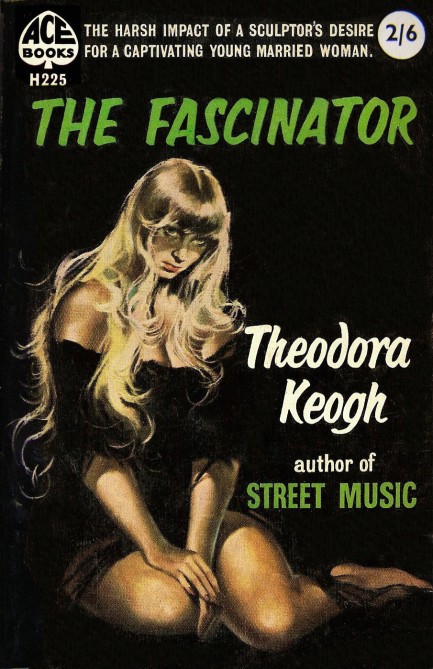
Spouses who cheat usually don't do so because their fling is more attractive than their partner. We learned this years ago from a widely noted survey of cheaters. What attracts them is that the person they desire is more exciting. Theodora Keogh's 1954 novel The Fascinator encapsulates this idea. It's about a woman's attraction to a man who's more exciting than her husband. The other man, Zanic, is ugly due to a congenital condition that made his brows and ears grow so he looks like an ape, and he's also overweight. But no matter—he's a sculptor and an elegant speaker and all the rest, so the story, as it develops, follows whether the main character Ellen will actually cheat with this persistent and somewhat creepy ogre of a man who she finds more exciting than her handsome but normal husband. It's not the type of book we usually read, but blame the cover art for that. It drew us because we thought it might be another Sandro Symeoni effort for Ace Books. It's uncredited, but we suspect Sandro's brush. Why? Look here. In any case The Fascinator is well written and thoughtful.
 Anything could happen there and it usually did. 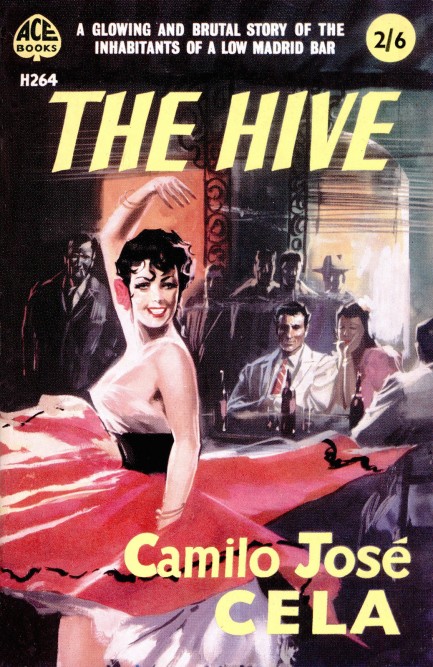
We're drawn to books about places we know, so Camilo José Cela's The Hive was a natural. Originally published in 1950 and titled La colmena, the tale is largely set in a Madrid bar known as Doña Rosa's Café. There are also scenes set in apartments, streets, and other cafés, as Cela explores the lives of more than three-hundred characters in brief sketches, slowly weaving these warp and weft strands into a tapestry that ultimately represents a single character—Madrid circa 1943. Maybe that doesn't sound thrilling, but we liked it. Cela was economical yet vivid, like here, at closing time for the café:
Within half an hour the café will be empty. It will be like a man who has suddenly lost his memory.
And here, about a boy who survives by singing on the street:
He is too young in years for cynicism—or resignation—to have slashed its mark across his face, and therefore it has a beautiful, candid stupidity, the expression of one who understands nothing of anything that happens. For [him] everything that happens is a miracle: he was born by a miracle, he eats by a miracle, has lived by a miracle, and has the strength to sing by pure miracle.
Cela was a fascist, a supporter of Francisco Franco's dictatorship. His beliefs came with contradictions, for example he worked as a censor for the government, was himself banned so that The Hive had to be published first in Argentina, yet remained loyal to the regime that had financially and reputationally harmed him. He even became an informer. In Cela's writing there's humor, but also coldness, a sense of observing small and pathetic people. For someone born into material comfort in a Spain where many families retain unearned wealth for hundreds of years, his subtle judgements came across to us as cruel, the product of a person who looked closely at everyone but himself. The book isn't overtly political, though, which makes it easier to focus on the skill that eventually won him a Nobel Prize.
The edition you see here is from Ace Books in 1959 with an uncredited cover. We went back and forth on this artist. We want to say it's Sandro Symeoni, but we don't have enough cred to make that call definitively. It looks like some of the items he painted, but publishing companies sometimes sought art of similar styles, or directed illustrators to produce something similar to what another artist had provided. During the late 1950s and early ’60s Ace Books had many covers in this general style. That said, compare the close-ups below. The first is from the above cover, and the rest are from confirmed Symeonis. If The Hive wasn't painted by the same person, then whoever did paint it went beyond merely working in a similar style—he was a thief. 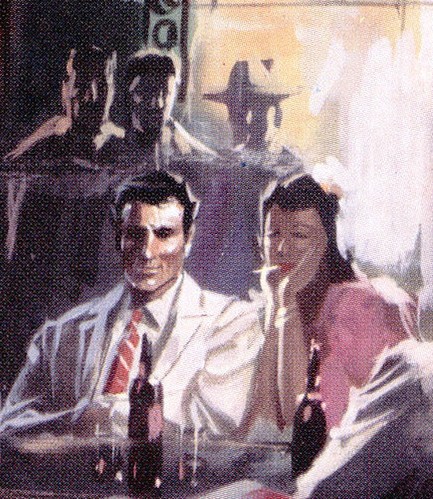 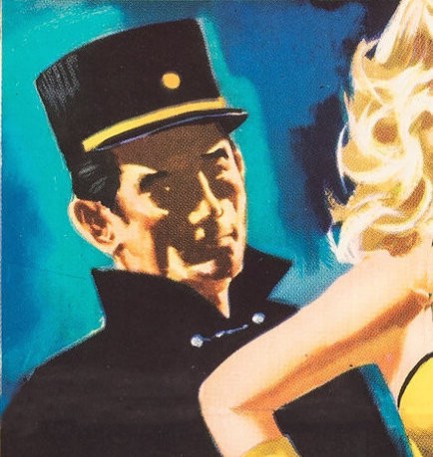 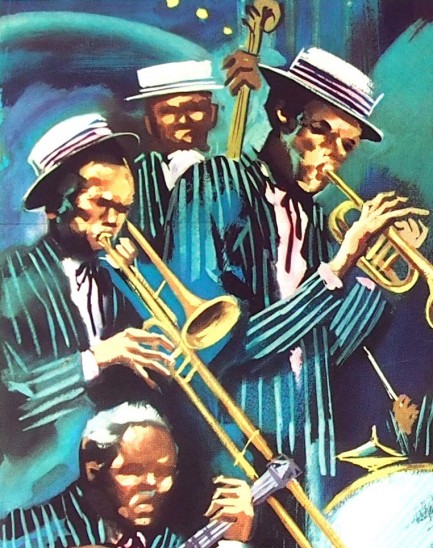 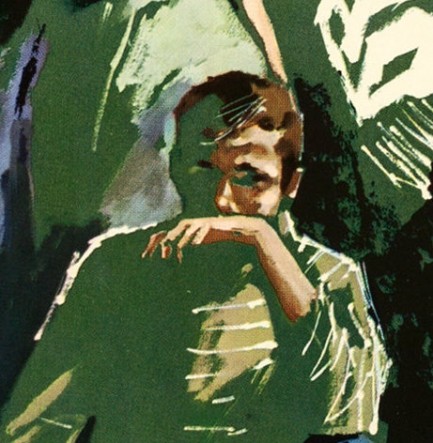 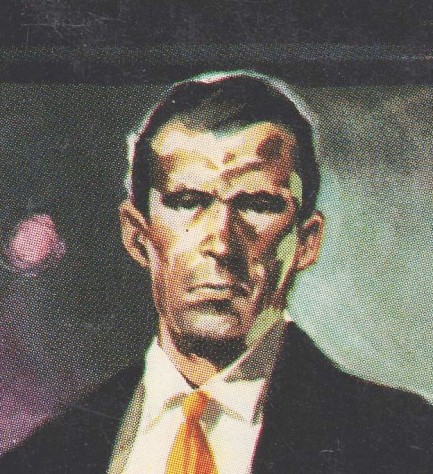
 Chandler's Los Angeles is dark day and night. 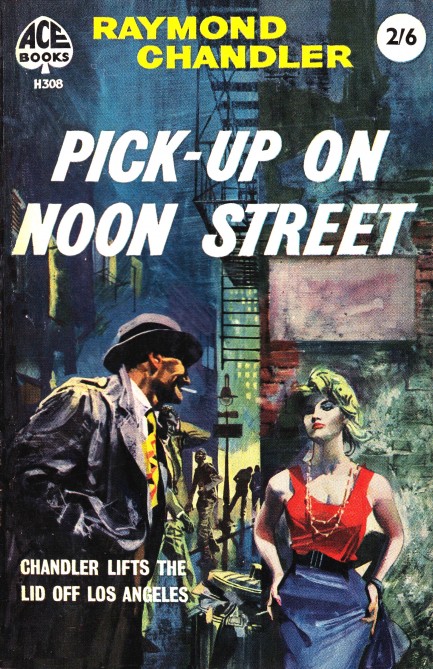
We're still marveling over Sandro Symeoni's cover work for Ace Books. Each is better than the next. The one above isn't signed, but it's him for sure—well, we think so. It's a beautiful street scene for Raymond Chandler's Pick-Up on Noon Street, not a novel but an anthology of medium length stories originally published in pulp magazines during the 1930s. The collection, comprising four tales set in Los Angeles, first came out in 1950, with this Ace edition appearing in 1960.
The title story was originally published in 1936 as “Noon Street Nemesis” and deals with an undercover narc named Pete Anglish, who accidentally becomes involved in kidnapping and human trafficking. The story is unique because it's set partly in L.A's African American community and it doesn't traffic in the disparaging terminology you usually find under such circumstances. There are good guys and bad guys of all types, with no particular weight given to their backgrounds. It's also a good tale.
In 1935's “Nevada Gas” the title refers to cyanide gas, which comes into play in a specially modified limousine two killers use to execute an unfortunate in the back seat. A Los Angeles tough guy with the excellent name Johnny De Ruse learns that the car was an exact duplicate of the murdered man's actual limousine, which he then entered with no clue the ride would be his last. That's a lot of effort to kill a man, and it intrigues De Ruse greatly, but his curiosity draws the attention of several lethal characters.
In 1934's “Smart-Aleck Kill” a tough Tinseltown detective named Johnny Dalmas tries to solve a murder the cops think was a suicide. The victim was a director of smut movies, but the reasons for his death have to do with something else entirely, and Dalmas has to dodge bullets and overcome duplicity to solve the case.
In 1936's “Guns at Cyrano's” a detective-turned-hotelier named Ted Carmady finds a beautiful blonde who's been knocked out in one of his rooms, and lets his protectiveness lead him into the world of gangsters and fixed prizefights. Cyrano's is a nightclub where the blonde works as a dancer, and where Carmady gets neck deep in murder.
Of the four stories, we liked “Nevada Gas” the best because the character of De Ruse was the most interesting and resourceful, but the leads are all similar—all are basically cousins of Philip Marlowe, kicking ass and taking names in an L.A. rife with hustlers, thugs, wise-ass cops, and corrupt one percenters. If you think of Pick-Up on Noon Street as a sort of Marlowe sampler plate, it should certainly do the job of making you hungry for the main course.
 A nocturnal perpetrator is revealed thanks to key evidence. 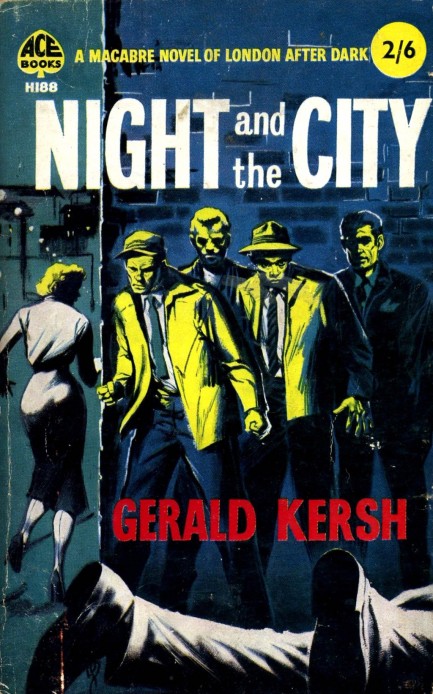 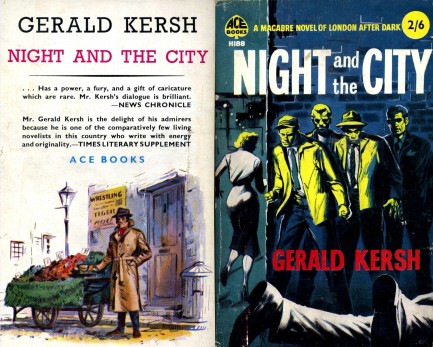
Above you see a beautiful paperback cover, both front and back, for Gerald Kersh's classic drama Night and the City, basis for the famed 1950 film noir. We have a copy of the book, so we may get back to it later. We're sharing the cover because it was painted by Sandro Symeoni. Back when we first stumbled upon this genius more than a decade ago there was little online about him. Now he has a Twitter page, a dedicated website currently in mid-build, plus a recent Facebook group. All of this means his profile is growing, which in turn means more attributed pieces appearing.
But attribution can be tricky. Symeoni was a chameleonic artist, with a style that evolved so much that even with the presence of his signature removing all doubt as to the provenance of the work, it's still hard to imagination that he painted with such range. And of course, some of his pieces don't have signatures, often because it was covered or cropped, and in those cases a little detective work is needed. The above cover is a good example. It's not signed, and has not been attributed to Symeoni anywhere, but it's him.
Note the background perspective on the left side, the chain of streetlights that draws the eye beyond the female figure. For a while this was Symeoni's thing, and it appeared in much of his work. For example, 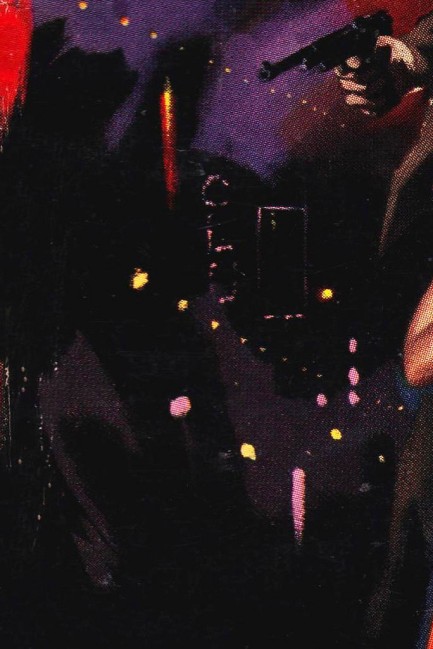  check this section at right (or above if you're using a mobile device) of his cover for the Peter Cheyney novel He Walked in Her Sleep (full cover here). check this section at right (or above if you're using a mobile device) of his cover for the Peter Cheyney novel He Walked in Her Sleep (full cover here). And directly below that example you see another, more subtle version of it in a crop we've made of his poster for La strada della vergogna (full poster here). Again you see a pretty chain of light receding from the viewer, plus a few impressionistic dots of nocturnal illumination. We have a few more examples below, but what you've already seen is probably convincing enough. These are all unmistakably by the same hand.
Simultaneously, Symeoni used another stylistic trademark on the Kersh cover—flourescent yellow. You see that in the first two posters of this group. Sorry to ask you click over there, but if we added those examples here the post would become a real mess. In any case, you see what we mean about the light. With both the perspective and dayglow yellow characteristics noted, plus the general similarity of style, there's little doubt this is Symeoni's work. The final piece of evidence is simply that he's known to have produced pieces for Ace Books between 1958 and 1960, if not even a year or two later. This is an Ace cover, thus the case becomes open and shut. Well, maybe it wouldn't hold up in court, but it's good enough for here. Verdict reached: Symeoni.
Below we've uploaded a few movie posters, confirmed as Symeoni's, in which he uses the perspective technique noted above. They'll help to reinforce our conclusion. Again, stylistically he was wide ranging. In addition to what you see here he painted portraits, delved deeply into color blocking, painted with abstract and blank backgrounds, drew in ink, painted humorous pieces, and created scores of unique fonts. But of all his styles we like these nighttime masterpieces best. More from this virtuoso later.
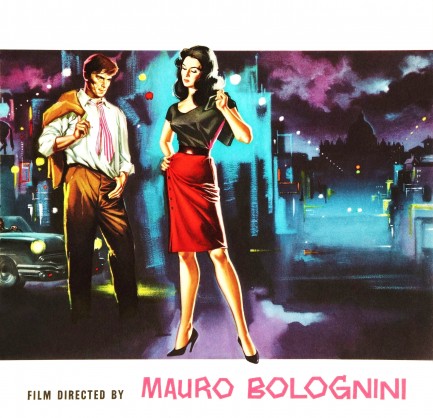 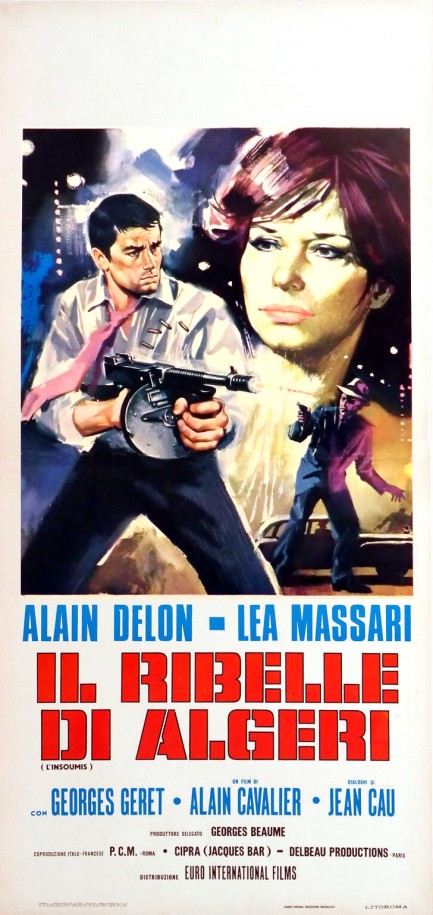 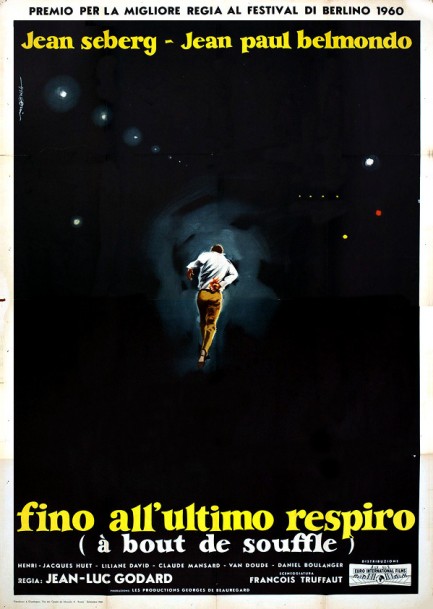

|
 |

The headlines that mattered yesteryear.
2003—Hope Dies
Film legend Bob Hope dies of pneumonia two months after celebrating his 100th birthday. 1945—Churchill Given the Sack
In spite of admiring Winston Churchill as a great wartime leader, Britons elect
Clement Attlee the nation's new prime minister in a sweeping victory for the Labour Party over the Conservatives. 1952—Evita Peron Dies
Eva Duarte de Peron, aka Evita, wife of the president of the Argentine Republic, dies from cancer at age 33. Evita had brought the working classes into a position of political power never witnessed before, but was hated by the nation's powerful military class. She is lain to rest in Milan, Italy in a secret grave under a nun's name, but is eventually returned to Argentina for reburial beside her husband in 1974. 1943—Mussolini Calls It Quits
Italian dictator Benito Mussolini steps down as head of the armed forces and the government. It soon becomes clear that Il Duce did not relinquish power voluntarily, but was forced to resign after former Fascist colleagues turned against him. He is later installed by Germany as leader of the Italian Social Republic in the north of the country, but is killed by partisans in 1945.
|

|
|

It's easy. We have an uploader that makes it a snap. Use it to submit your art, text, header, and subhead. Your post can be funny, serious, or anything in between, as long as it's vintage pulp. You'll get a byline and experience the fleeting pride of free authorship. We'll edit your post for typos, but the rest is up to you. Click here to give us your best shot.

|
|










 role as Albright's cousin and household helper. The two are soon in competition for Delon's affections, though he never forgets that his main goal is to escape the mobsters. While the general thrust of the plot remains a mystery as in Keene's novel, there's a heavy dose of action too, with excellent stunts. The ending differs as well.
role as Albright's cousin and household helper. The two are soon in competition for Delon's affections, though he never forgets that his main goal is to escape the mobsters. While the general thrust of the plot remains a mystery as in Keene's novel, there's a heavy dose of action too, with excellent stunts. The ending differs as well.










































 check this section at right (or above if you're using a mobile device) of his cover for the Peter Cheyney novel He Walked in Her Sleep (full cover here).
check this section at right (or above if you're using a mobile device) of his cover for the Peter Cheyney novel He Walked in Her Sleep (full cover here).







































































